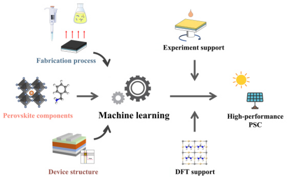Home > Press > Predicting the device performance of the perovskite solar cells from the experimental parameters through machine learning of existing experimental results
 |
| Screening the fabrication process parameters for perovskite solar cells by machine learning.
CREDIT Journal of Energy Chemistry |
Abstract:
Metal halide perovskite solar cells (PSCs) have been rapidly developed in the past decade. To obtain high-performance PSCs, it is imperative to optimize the fabrication processes and the composition of the perovskite films. Extensive work has been carried out to determine the effects of the fabrication processes and composition of the perovskite films on the device performance. However, it has been challenging to elucidate their correlations because of the enormous variable space constructed by these factors. Exploring these relations is undoubtedly critical to predict the device performance for efficient device optimization. However, owing to the complexity of these factors, it has been impossible thus far to carry out this work solely through experimentation.
Predicting the device performance of the perovskite solar cells from the experimental parameters through machine learning of existing experimental results
Dalian, China | Posted on November 18th, 2022
constructed by these factors. Exploring these relations is undoubtedly critical to predict the device performance for efficient device optimization. However, owing to the complexity of these factors, it has been impossible thus far to carry out this work solely through experimentation.
Recently, Professor Zheng Xu and Associate Professor Dandan Song of Beijing Jiaotong University adopted the machine learning (ML) approach to explore these correlations by learning the existing experimental results, thereby enabling the prediction of the device performance from these factors. The effects of these factors on the device performance were analyzed by shapley additive explanations (SHAP) analysis. Furthermore, to improve the interpretability of the ML model, the authors considered A-site cations as an example to explain and verify the predicted results by density functional theory (DFT) calculations and experiments. This work thoroughly elucidates how ML guides device optimization, thereby also serving as a guide for the reverse design of experiments to obtain high-performance PSCs.
This research was published in the Journal of Energy Chemistry as Predicting the device performance of the perovskite solar cells from the experimental parameters through machine learning of existing experimental results.
####
About Dalian Institute of Chemical Physics, Chinese Academy Sciences
About the journal
The Journal of Energy Chemistry is a publication that mainly reports on creative researches and innovative applications of chemical conversions of fossil energy, carbon dioxide, electrochemical energy and hydrogen energy, as well as the conversions of biomass and solar energy related with chemical issues to promote academic exchanges in the field of energy chemistry and to accelerate the exploration, research and development of energy science and technologies.
For more information, please click here
Contacts:
Xiaoluan Wei
Dalian Institute of Chemical Physics, Chinese Academy Sciences
Office: 86-041-184-379-021
Copyright © Dalian Institute of Chemical Physics, Chinese Academy Sciences
If you have a comment, please Contact us.
Issuers of news releases, not 7th Wave, Inc. or Nanotechnology Now, are solely responsible for the accuracy of the content.
News and information
![]()
HKUST researchers develop a novel integration scheme for efficient coupling between III-V and silicon November 18th, 2022
![]()
Researchers at Purdue unlock light-matter interactions on sub-nanometer scales, leading to picophotonics November 18th, 2022
![]()
Rice turns asphaltene into graphene for composites: Flashed byproduct of crude oil could bolster materials, polymer inks November 18th, 2022
![]()
How 2D materials expand: New technique that accurately measures how atom-thin materials expand when heated could help engineers develop faster, more powerful electronic devices November 18th, 2022
Perovskites
![]()
Scientists have proposed a new material for perovskite solar cells: It is cheaper its analogues, easier to manufacture and to modify October 28th, 2022
![]()
Solvent study solves solar cell durability puzzle: Rice-led project could make perovskite cells ready for prime time September 23rd, 2022
![]()
Lattice distortion of perovskite quantum dots induces coherent quantum beating September 9th, 2022
Possible Futures
![]()
HKUST researchers develop a novel integration scheme for efficient coupling between III-V and silicon November 18th, 2022
![]()
NISTs grid of quantum islands could reveal secrets for powerful technologies November 18th, 2022
Discoveries
![]()
An on-chip time-lens generates ultrafast pulses: New device opens the doors to applications in communication, quantum computing, astronomy November 18th, 2022
![]()
Researchers at Purdue unlock light-matter interactions on sub-nanometer scales, leading to picophotonics November 18th, 2022
![]()
Rice turns asphaltene into graphene for composites: Flashed byproduct of crude oil could bolster materials, polymer inks November 18th, 2022
![]()
How 2D materials expand: New technique that accurately measures how atom-thin materials expand when heated could help engineers develop faster, more powerful electronic devices November 18th, 2022
Announcements
![]()
HKUST researchers develop a novel integration scheme for efficient coupling between III-V and silicon November 18th, 2022
![]()
NISTs grid of quantum islands could reveal secrets for powerful technologies November 18th, 2022
![]()
How 2D materials expand: New technique that accurately measures how atom-thin materials expand when heated could help engineers develop faster, more powerful electronic devices November 18th, 2022
Interviews/Book Reviews/Essays/Reports/Podcasts/Journals/White papers/Posters
![]()
An on-chip time-lens generates ultrafast pulses: New device opens the doors to applications in communication, quantum computing, astronomy November 18th, 2022
![]()
Researchers at Purdue unlock light-matter interactions on sub-nanometer scales, leading to picophotonics November 18th, 2022
![]()
Rice turns asphaltene into graphene for composites: Flashed byproduct of crude oil could bolster materials, polymer inks November 18th, 2022
![]()
How 2D materials expand: New technique that accurately measures how atom-thin materials expand when heated could help engineers develop faster, more powerful electronic devices November 18th, 2022
Energy
![]()
Rice turns asphaltene into graphene for composites: Flashed byproduct of crude oil could bolster materials, polymer inks November 18th, 2022
![]()
New insights into energy loss open doors for one up-and-coming solar tech November 18th, 2022
![]()
Advances in thermoelectric power generation possible with various metal chalcogenide materials, recent review shows November 4th, 2022
![]()
New catalyst can turn smelly hydrogen sulfide into a cash cow: Light-powered catalyst makes hydrogen energy from pungent gas in one-step process November 3rd, 2022
Solar/Photovoltaic
![]()
New insights into energy loss open doors for one up-and-coming solar tech November 18th, 2022
![]()
Scientists have proposed a new material for perovskite solar cells: It is cheaper its analogues, easier to manufacture and to modify October 28th, 2022
![]()
Current and Future Developments in Nanomaterials and Carbon Nanotubes: Applications of Nanomaterials in Energy Storage and Electronics October 28th, 2022
![]()
Solvent study solves solar cell durability puzzle: Rice-led project could make perovskite cells ready for prime time September 23rd, 2022










